Nature and Management of Business Organizations in the UK
VerifiedAdded on 2023/06/08
|8
|2653
|429
AI Summary
This report explains the nature and management of different types of business organizations in the UK like sole trader, partnership, limited company and limited liability partnership. It also describes the key sources of laws as the legal context for business organizations in the UK. The report recommends limited liability company as the most suitable form of business organization for Sam who is a sole trader of IOM Solutions.
Contribute Materials
Your contribution can guide someone’s learning journey. Share your
documents today.
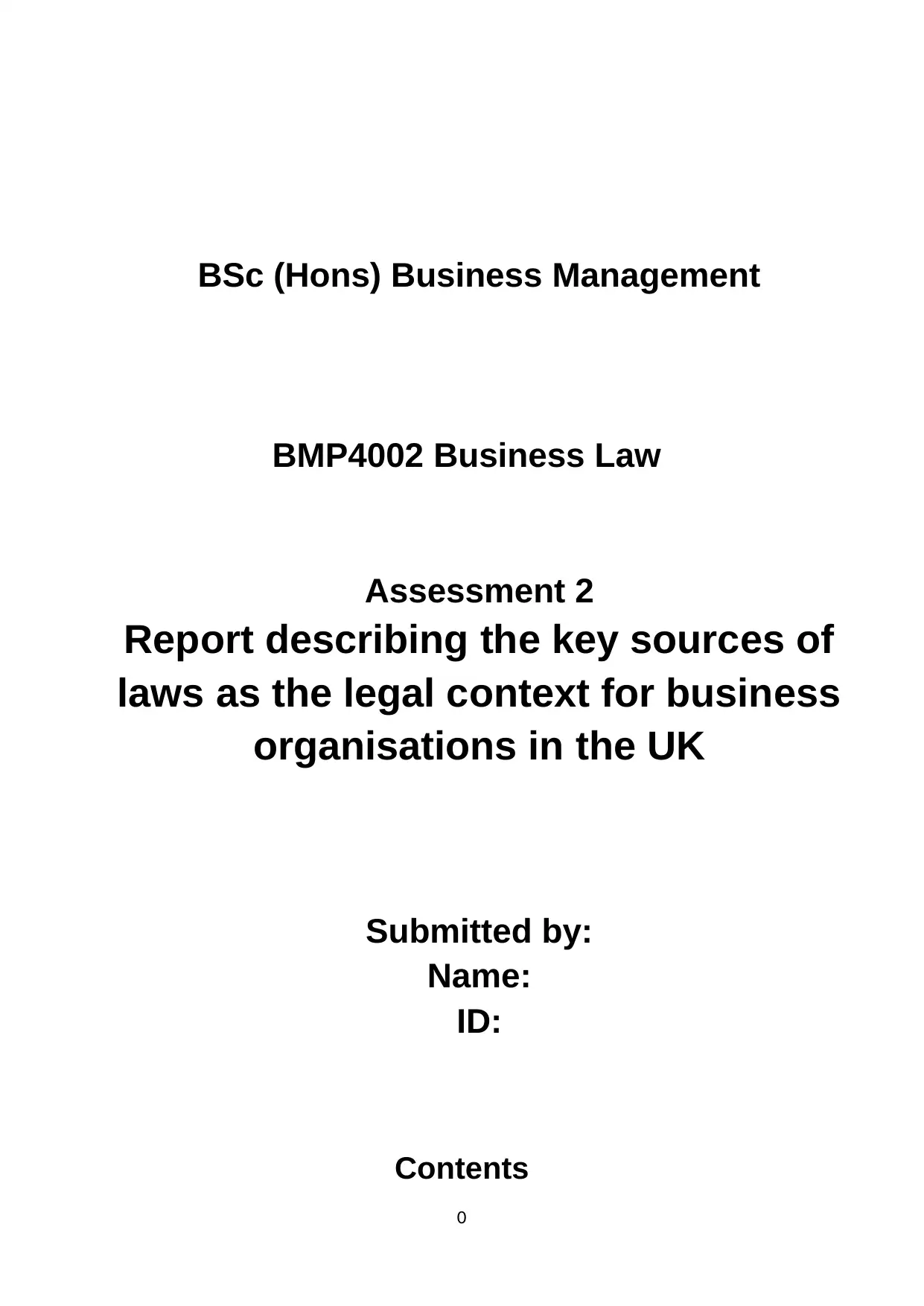
BSc (Hons) Business Management
BMP4002 Business Law
Assessment 2
Report describing the key sources of
laws as the legal context for business
organisations in the UK
Submitted by:
Name:
ID:
Contents
0
BMP4002 Business Law
Assessment 2
Report describing the key sources of
laws as the legal context for business
organisations in the UK
Submitted by:
Name:
ID:
Contents
0
Secure Best Marks with AI Grader
Need help grading? Try our AI Grader for instant feedback on your assignments.
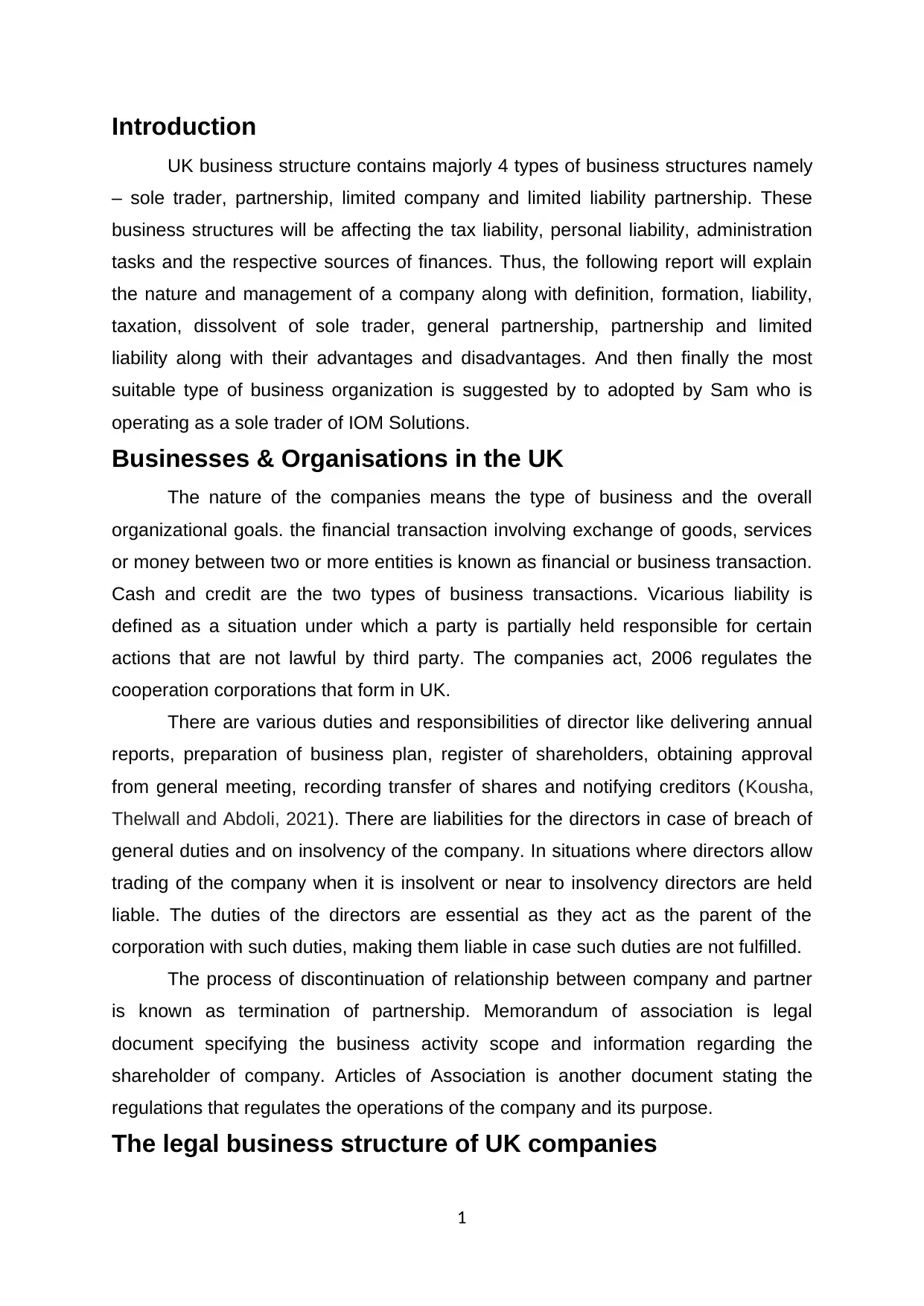
Introduction
UK business structure contains majorly 4 types of business structures namely
– sole trader, partnership, limited company and limited liability partnership. These
business structures will be affecting the tax liability, personal liability, administration
tasks and the respective sources of finances. Thus, the following report will explain
the nature and management of a company along with definition, formation, liability,
taxation, dissolvent of sole trader, general partnership, partnership and limited
liability along with their advantages and disadvantages. And then finally the most
suitable type of business organization is suggested by to adopted by Sam who is
operating as a sole trader of IOM Solutions.
Businesses & Organisations in the UK
The nature of the companies means the type of business and the overall
organizational goals. the financial transaction involving exchange of goods, services
or money between two or more entities is known as financial or business transaction.
Cash and credit are the two types of business transactions. Vicarious liability is
defined as a situation under which a party is partially held responsible for certain
actions that are not lawful by third party. The companies act, 2006 regulates the
cooperation corporations that form in UK.
There are various duties and responsibilities of director like delivering annual
reports, preparation of business plan, register of shareholders, obtaining approval
from general meeting, recording transfer of shares and notifying creditors (Kousha,
Thelwall and Abdoli, 2021). There are liabilities for the directors in case of breach of
general duties and on insolvency of the company. In situations where directors allow
trading of the company when it is insolvent or near to insolvency directors are held
liable. The duties of the directors are essential as they act as the parent of the
corporation with such duties, making them liable in case such duties are not fulfilled.
The process of discontinuation of relationship between company and partner
is known as termination of partnership. Memorandum of association is legal
document specifying the business activity scope and information regarding the
shareholder of company. Articles of Association is another document stating the
regulations that regulates the operations of the company and its purpose.
The legal business structure of UK companies
1
UK business structure contains majorly 4 types of business structures namely
– sole trader, partnership, limited company and limited liability partnership. These
business structures will be affecting the tax liability, personal liability, administration
tasks and the respective sources of finances. Thus, the following report will explain
the nature and management of a company along with definition, formation, liability,
taxation, dissolvent of sole trader, general partnership, partnership and limited
liability along with their advantages and disadvantages. And then finally the most
suitable type of business organization is suggested by to adopted by Sam who is
operating as a sole trader of IOM Solutions.
Businesses & Organisations in the UK
The nature of the companies means the type of business and the overall
organizational goals. the financial transaction involving exchange of goods, services
or money between two or more entities is known as financial or business transaction.
Cash and credit are the two types of business transactions. Vicarious liability is
defined as a situation under which a party is partially held responsible for certain
actions that are not lawful by third party. The companies act, 2006 regulates the
cooperation corporations that form in UK.
There are various duties and responsibilities of director like delivering annual
reports, preparation of business plan, register of shareholders, obtaining approval
from general meeting, recording transfer of shares and notifying creditors (Kousha,
Thelwall and Abdoli, 2021). There are liabilities for the directors in case of breach of
general duties and on insolvency of the company. In situations where directors allow
trading of the company when it is insolvent or near to insolvency directors are held
liable. The duties of the directors are essential as they act as the parent of the
corporation with such duties, making them liable in case such duties are not fulfilled.
The process of discontinuation of relationship between company and partner
is known as termination of partnership. Memorandum of association is legal
document specifying the business activity scope and information regarding the
shareholder of company. Articles of Association is another document stating the
regulations that regulates the operations of the company and its purpose.
The legal business structure of UK companies
1
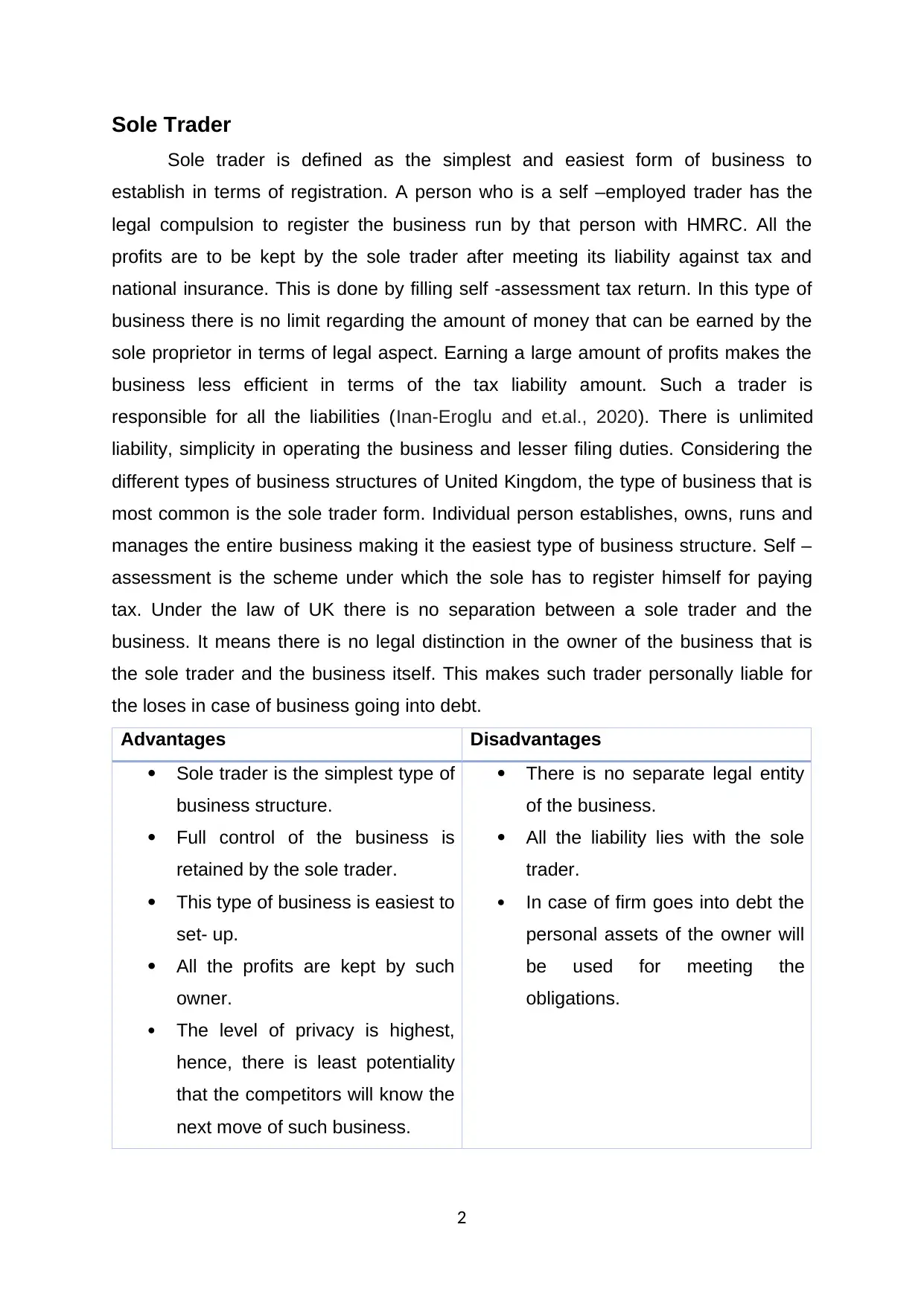
Sole Trader
Sole trader is defined as the simplest and easiest form of business to
establish in terms of registration. A person who is a self –employed trader has the
legal compulsion to register the business run by that person with HMRC. All the
profits are to be kept by the sole trader after meeting its liability against tax and
national insurance. This is done by filling self -assessment tax return. In this type of
business there is no limit regarding the amount of money that can be earned by the
sole proprietor in terms of legal aspect. Earning a large amount of profits makes the
business less efficient in terms of the tax liability amount. Such a trader is
responsible for all the liabilities (Inan-Eroglu and et.al., 2020). There is unlimited
liability, simplicity in operating the business and lesser filing duties. Considering the
different types of business structures of United Kingdom, the type of business that is
most common is the sole trader form. Individual person establishes, owns, runs and
manages the entire business making it the easiest type of business structure. Self –
assessment is the scheme under which the sole has to register himself for paying
tax. Under the law of UK there is no separation between a sole trader and the
business. It means there is no legal distinction in the owner of the business that is
the sole trader and the business itself. This makes such trader personally liable for
the loses in case of business going into debt.
Advantages Disadvantages
Sole trader is the simplest type of
business structure.
Full control of the business is
retained by the sole trader.
This type of business is easiest to
set- up.
All the profits are kept by such
owner.
The level of privacy is highest,
hence, there is least potentiality
that the competitors will know the
next move of such business.
There is no separate legal entity
of the business.
All the liability lies with the sole
trader.
In case of firm goes into debt the
personal assets of the owner will
be used for meeting the
obligations.
2
Sole trader is defined as the simplest and easiest form of business to
establish in terms of registration. A person who is a self –employed trader has the
legal compulsion to register the business run by that person with HMRC. All the
profits are to be kept by the sole trader after meeting its liability against tax and
national insurance. This is done by filling self -assessment tax return. In this type of
business there is no limit regarding the amount of money that can be earned by the
sole proprietor in terms of legal aspect. Earning a large amount of profits makes the
business less efficient in terms of the tax liability amount. Such a trader is
responsible for all the liabilities (Inan-Eroglu and et.al., 2020). There is unlimited
liability, simplicity in operating the business and lesser filing duties. Considering the
different types of business structures of United Kingdom, the type of business that is
most common is the sole trader form. Individual person establishes, owns, runs and
manages the entire business making it the easiest type of business structure. Self –
assessment is the scheme under which the sole has to register himself for paying
tax. Under the law of UK there is no separation between a sole trader and the
business. It means there is no legal distinction in the owner of the business that is
the sole trader and the business itself. This makes such trader personally liable for
the loses in case of business going into debt.
Advantages Disadvantages
Sole trader is the simplest type of
business structure.
Full control of the business is
retained by the sole trader.
This type of business is easiest to
set- up.
All the profits are kept by such
owner.
The level of privacy is highest,
hence, there is least potentiality
that the competitors will know the
next move of such business.
There is no separate legal entity
of the business.
All the liability lies with the sole
trader.
In case of firm goes into debt the
personal assets of the owner will
be used for meeting the
obligations.
2
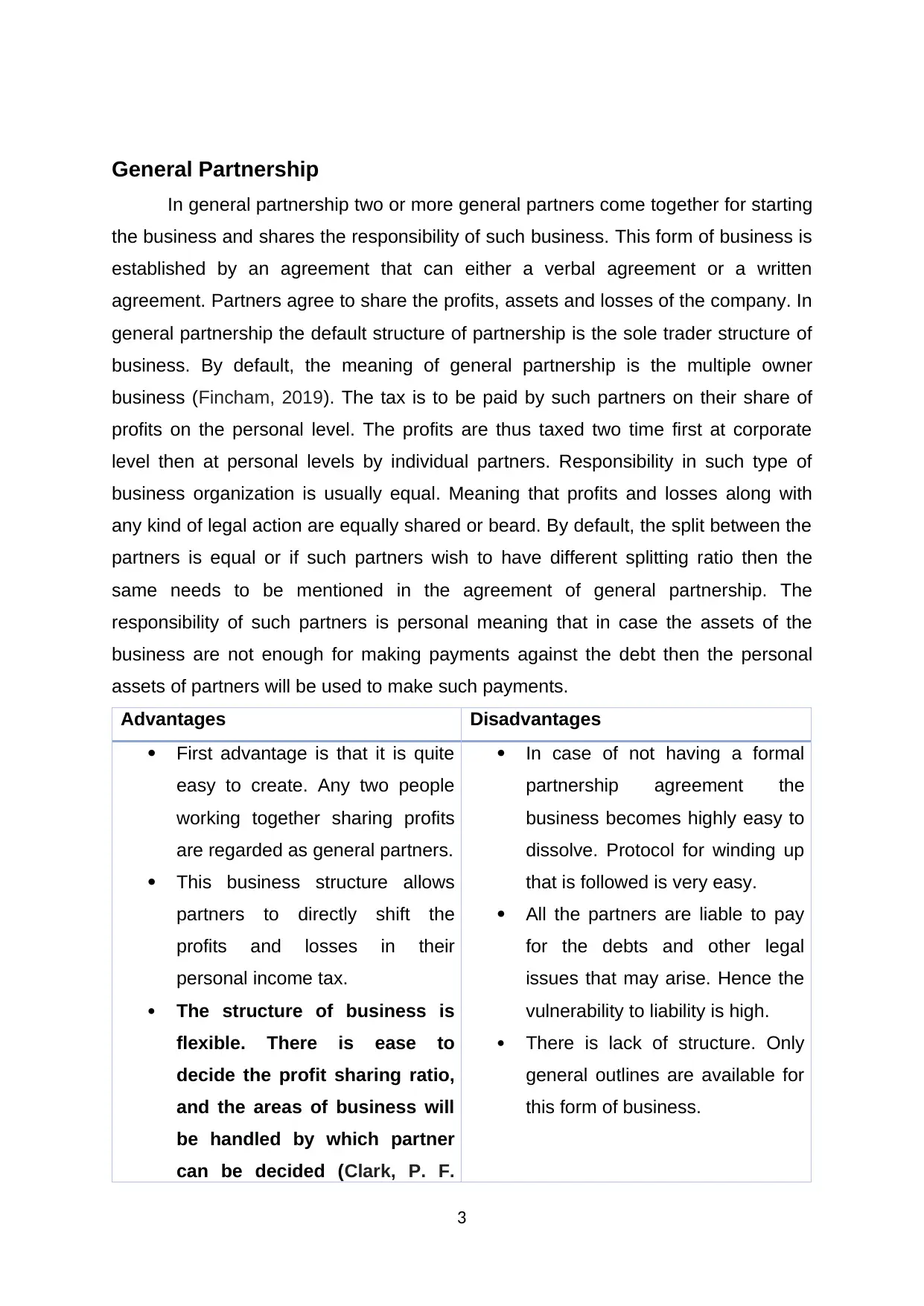
General Partnership
In general partnership two or more general partners come together for starting
the business and shares the responsibility of such business. This form of business is
established by an agreement that can either a verbal agreement or a written
agreement. Partners agree to share the profits, assets and losses of the company. In
general partnership the default structure of partnership is the sole trader structure of
business. By default, the meaning of general partnership is the multiple owner
business (Fincham, 2019). The tax is to be paid by such partners on their share of
profits on the personal level. The profits are thus taxed two time first at corporate
level then at personal levels by individual partners. Responsibility in such type of
business organization is usually equal. Meaning that profits and losses along with
any kind of legal action are equally shared or beard. By default, the split between the
partners is equal or if such partners wish to have different splitting ratio then the
same needs to be mentioned in the agreement of general partnership. The
responsibility of such partners is personal meaning that in case the assets of the
business are not enough for making payments against the debt then the personal
assets of partners will be used to make such payments.
Advantages Disadvantages
First advantage is that it is quite
easy to create. Any two people
working together sharing profits
are regarded as general partners.
This business structure allows
partners to directly shift the
profits and losses in their
personal income tax.
The structure of business is
flexible. There is ease to
decide the profit sharing ratio,
and the areas of business will
be handled by which partner
can be decided (Clark, P. F.
In case of not having a formal
partnership agreement the
business becomes highly easy to
dissolve. Protocol for winding up
that is followed is very easy.
All the partners are liable to pay
for the debts and other legal
issues that may arise. Hence the
vulnerability to liability is high.
There is lack of structure. Only
general outlines are available for
this form of business.
3
In general partnership two or more general partners come together for starting
the business and shares the responsibility of such business. This form of business is
established by an agreement that can either a verbal agreement or a written
agreement. Partners agree to share the profits, assets and losses of the company. In
general partnership the default structure of partnership is the sole trader structure of
business. By default, the meaning of general partnership is the multiple owner
business (Fincham, 2019). The tax is to be paid by such partners on their share of
profits on the personal level. The profits are thus taxed two time first at corporate
level then at personal levels by individual partners. Responsibility in such type of
business organization is usually equal. Meaning that profits and losses along with
any kind of legal action are equally shared or beard. By default, the split between the
partners is equal or if such partners wish to have different splitting ratio then the
same needs to be mentioned in the agreement of general partnership. The
responsibility of such partners is personal meaning that in case the assets of the
business are not enough for making payments against the debt then the personal
assets of partners will be used to make such payments.
Advantages Disadvantages
First advantage is that it is quite
easy to create. Any two people
working together sharing profits
are regarded as general partners.
This business structure allows
partners to directly shift the
profits and losses in their
personal income tax.
The structure of business is
flexible. There is ease to
decide the profit sharing ratio,
and the areas of business will
be handled by which partner
can be decided (Clark, P. F.
In case of not having a formal
partnership agreement the
business becomes highly easy to
dissolve. Protocol for winding up
that is followed is very easy.
All the partners are liable to pay
for the debts and other legal
issues that may arise. Hence the
vulnerability to liability is high.
There is lack of structure. Only
general outlines are available for
this form of business.
3
Secure Best Marks with AI Grader
Need help grading? Try our AI Grader for instant feedback on your assignments.
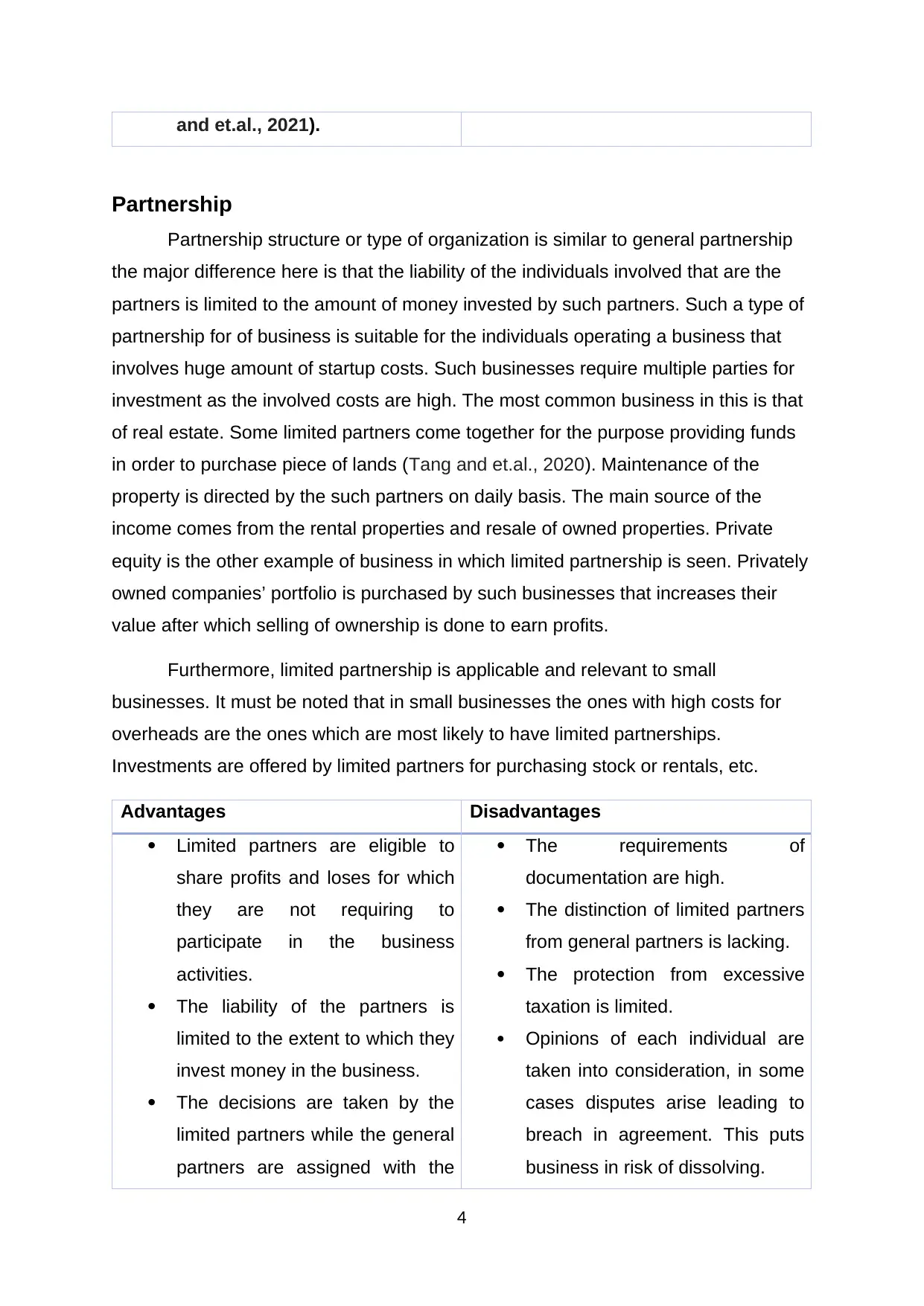
and et.al., 2021).
Partnership
Partnership structure or type of organization is similar to general partnership
the major difference here is that the liability of the individuals involved that are the
partners is limited to the amount of money invested by such partners. Such a type of
partnership for of business is suitable for the individuals operating a business that
involves huge amount of startup costs. Such businesses require multiple parties for
investment as the involved costs are high. The most common business in this is that
of real estate. Some limited partners come together for the purpose providing funds
in order to purchase piece of lands (Tang and et.al., 2020). Maintenance of the
property is directed by the such partners on daily basis. The main source of the
income comes from the rental properties and resale of owned properties. Private
equity is the other example of business in which limited partnership is seen. Privately
owned companies’ portfolio is purchased by such businesses that increases their
value after which selling of ownership is done to earn profits.
Furthermore, limited partnership is applicable and relevant to small
businesses. It must be noted that in small businesses the ones with high costs for
overheads are the ones which are most likely to have limited partnerships.
Investments are offered by limited partners for purchasing stock or rentals, etc.
Advantages Disadvantages
Limited partners are eligible to
share profits and loses for which
they are not requiring to
participate in the business
activities.
The liability of the partners is
limited to the extent to which they
invest money in the business.
The decisions are taken by the
limited partners while the general
partners are assigned with the
The requirements of
documentation are high.
The distinction of limited partners
from general partners is lacking.
The protection from excessive
taxation is limited.
Opinions of each individual are
taken into consideration, in some
cases disputes arise leading to
breach in agreement. This puts
business in risk of dissolving.
4
Partnership
Partnership structure or type of organization is similar to general partnership
the major difference here is that the liability of the individuals involved that are the
partners is limited to the amount of money invested by such partners. Such a type of
partnership for of business is suitable for the individuals operating a business that
involves huge amount of startup costs. Such businesses require multiple parties for
investment as the involved costs are high. The most common business in this is that
of real estate. Some limited partners come together for the purpose providing funds
in order to purchase piece of lands (Tang and et.al., 2020). Maintenance of the
property is directed by the such partners on daily basis. The main source of the
income comes from the rental properties and resale of owned properties. Private
equity is the other example of business in which limited partnership is seen. Privately
owned companies’ portfolio is purchased by such businesses that increases their
value after which selling of ownership is done to earn profits.
Furthermore, limited partnership is applicable and relevant to small
businesses. It must be noted that in small businesses the ones with high costs for
overheads are the ones which are most likely to have limited partnerships.
Investments are offered by limited partners for purchasing stock or rentals, etc.
Advantages Disadvantages
Limited partners are eligible to
share profits and loses for which
they are not requiring to
participate in the business
activities.
The liability of the partners is
limited to the extent to which they
invest money in the business.
The decisions are taken by the
limited partners while the general
partners are assigned with the
The requirements of
documentation are high.
The distinction of limited partners
from general partners is lacking.
The protection from excessive
taxation is limited.
Opinions of each individual are
taken into consideration, in some
cases disputes arise leading to
breach in agreement. This puts
business in risk of dissolving.
4
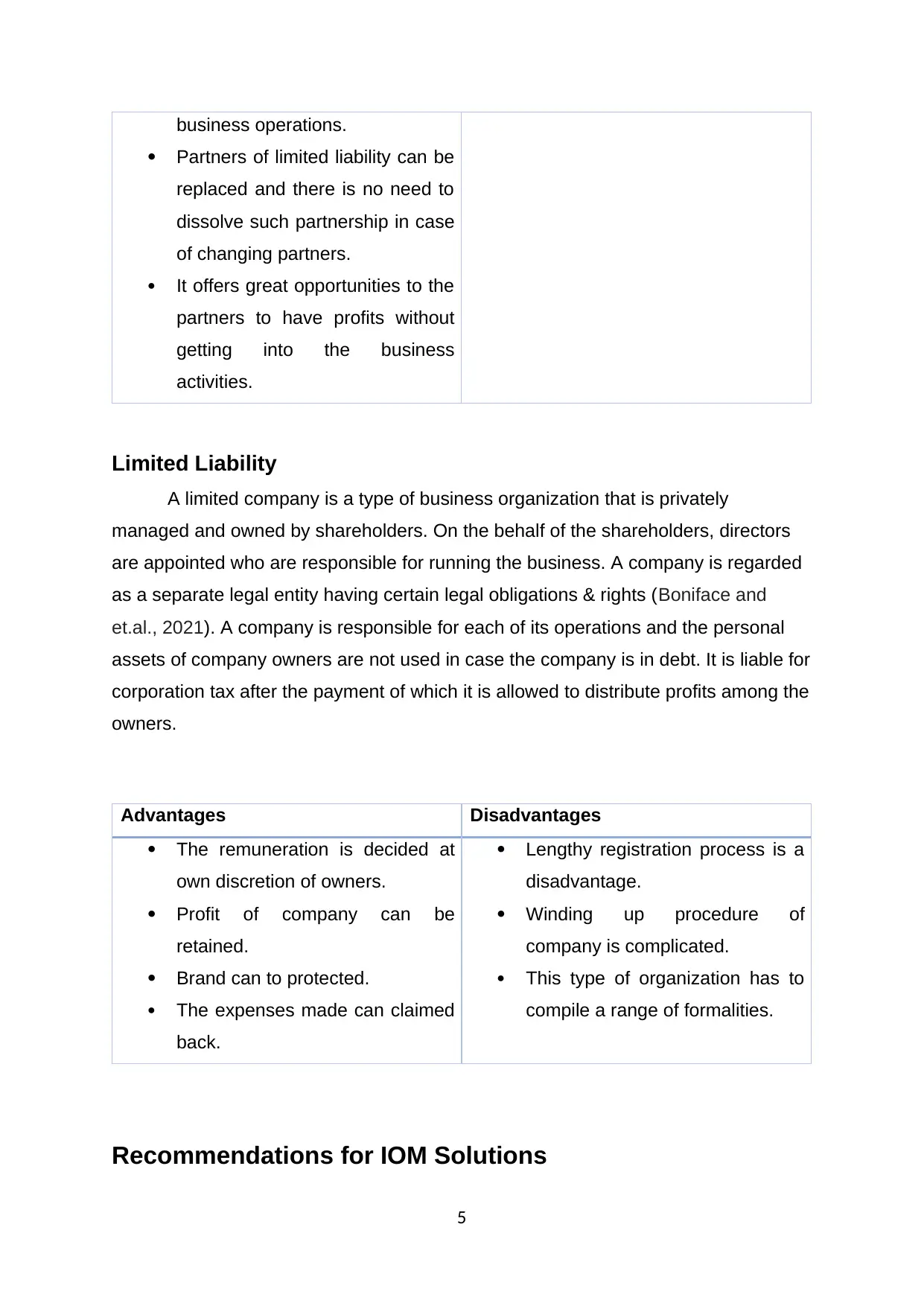
business operations.
Partners of limited liability can be
replaced and there is no need to
dissolve such partnership in case
of changing partners.
It offers great opportunities to the
partners to have profits without
getting into the business
activities.
Limited Liability
A limited company is a type of business organization that is privately
managed and owned by shareholders. On the behalf of the shareholders, directors
are appointed who are responsible for running the business. A company is regarded
as a separate legal entity having certain legal obligations & rights (Boniface and
et.al., 2021). A company is responsible for each of its operations and the personal
assets of company owners are not used in case the company is in debt. It is liable for
corporation tax after the payment of which it is allowed to distribute profits among the
owners.
Advantages Disadvantages
The remuneration is decided at
own discretion of owners.
Profit of company can be
retained.
Brand can to protected.
The expenses made can claimed
back.
Lengthy registration process is a
disadvantage.
Winding up procedure of
company is complicated.
This type of organization has to
compile a range of formalities.
Recommendations for IOM Solutions
5
Partners of limited liability can be
replaced and there is no need to
dissolve such partnership in case
of changing partners.
It offers great opportunities to the
partners to have profits without
getting into the business
activities.
Limited Liability
A limited company is a type of business organization that is privately
managed and owned by shareholders. On the behalf of the shareholders, directors
are appointed who are responsible for running the business. A company is regarded
as a separate legal entity having certain legal obligations & rights (Boniface and
et.al., 2021). A company is responsible for each of its operations and the personal
assets of company owners are not used in case the company is in debt. It is liable for
corporation tax after the payment of which it is allowed to distribute profits among the
owners.
Advantages Disadvantages
The remuneration is decided at
own discretion of owners.
Profit of company can be
retained.
Brand can to protected.
The expenses made can claimed
back.
Lengthy registration process is a
disadvantage.
Winding up procedure of
company is complicated.
This type of organization has to
compile a range of formalities.
Recommendations for IOM Solutions
5
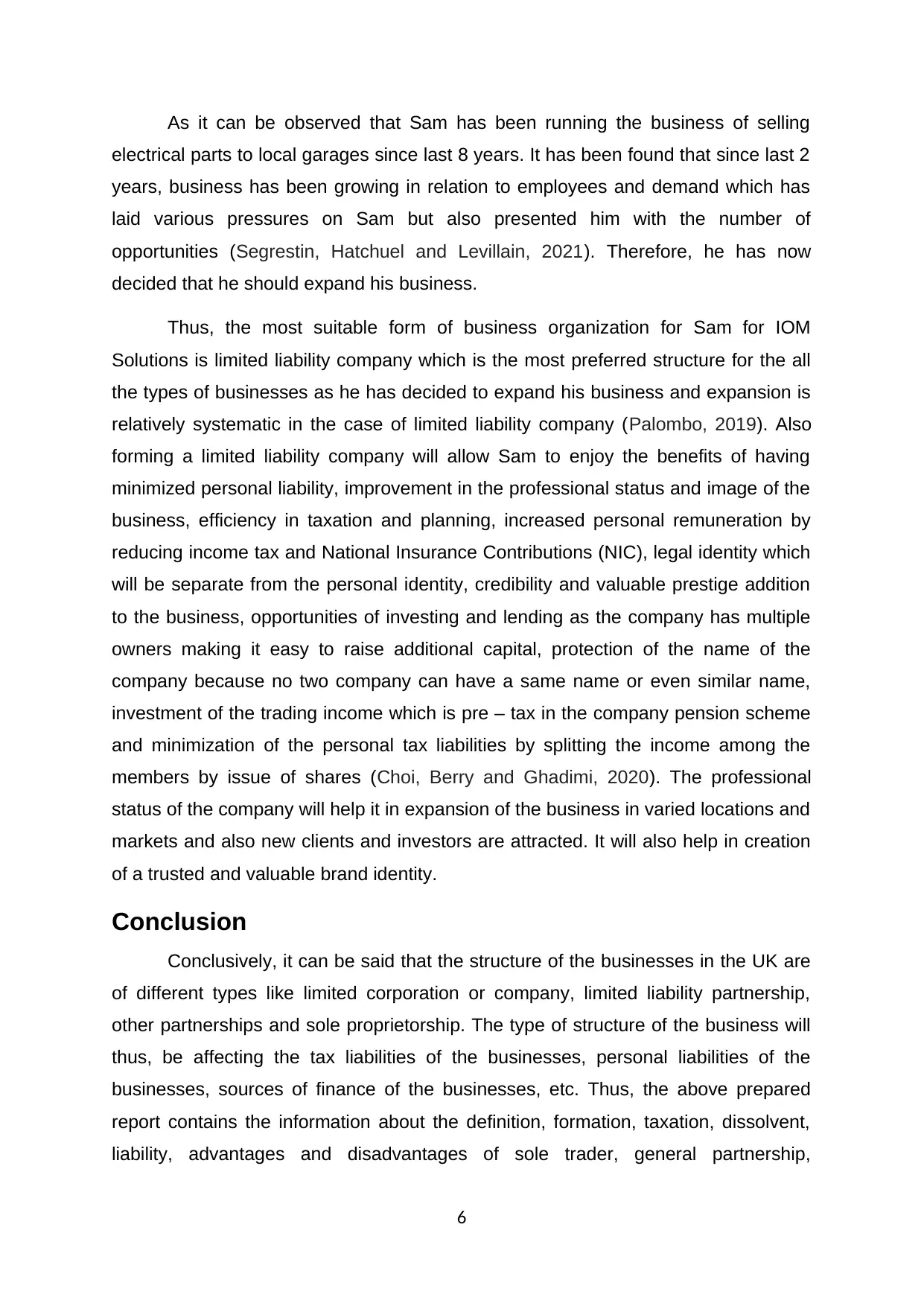
As it can be observed that Sam has been running the business of selling
electrical parts to local garages since last 8 years. It has been found that since last 2
years, business has been growing in relation to employees and demand which has
laid various pressures on Sam but also presented him with the number of
opportunities (Segrestin, Hatchuel and Levillain, 2021). Therefore, he has now
decided that he should expand his business.
Thus, the most suitable form of business organization for Sam for IOM
Solutions is limited liability company which is the most preferred structure for the all
the types of businesses as he has decided to expand his business and expansion is
relatively systematic in the case of limited liability company (Palombo, 2019). Also
forming a limited liability company will allow Sam to enjoy the benefits of having
minimized personal liability, improvement in the professional status and image of the
business, efficiency in taxation and planning, increased personal remuneration by
reducing income tax and National Insurance Contributions (NIC), legal identity which
will be separate from the personal identity, credibility and valuable prestige addition
to the business, opportunities of investing and lending as the company has multiple
owners making it easy to raise additional capital, protection of the name of the
company because no two company can have a same name or even similar name,
investment of the trading income which is pre – tax in the company pension scheme
and minimization of the personal tax liabilities by splitting the income among the
members by issue of shares (Choi, Berry and Ghadimi, 2020). The professional
status of the company will help it in expansion of the business in varied locations and
markets and also new clients and investors are attracted. It will also help in creation
of a trusted and valuable brand identity.
Conclusion
Conclusively, it can be said that the structure of the businesses in the UK are
of different types like limited corporation or company, limited liability partnership,
other partnerships and sole proprietorship. The type of structure of the business will
thus, be affecting the tax liabilities of the businesses, personal liabilities of the
businesses, sources of finance of the businesses, etc. Thus, the above prepared
report contains the information about the definition, formation, taxation, dissolvent,
liability, advantages and disadvantages of sole trader, general partnership,
6
electrical parts to local garages since last 8 years. It has been found that since last 2
years, business has been growing in relation to employees and demand which has
laid various pressures on Sam but also presented him with the number of
opportunities (Segrestin, Hatchuel and Levillain, 2021). Therefore, he has now
decided that he should expand his business.
Thus, the most suitable form of business organization for Sam for IOM
Solutions is limited liability company which is the most preferred structure for the all
the types of businesses as he has decided to expand his business and expansion is
relatively systematic in the case of limited liability company (Palombo, 2019). Also
forming a limited liability company will allow Sam to enjoy the benefits of having
minimized personal liability, improvement in the professional status and image of the
business, efficiency in taxation and planning, increased personal remuneration by
reducing income tax and National Insurance Contributions (NIC), legal identity which
will be separate from the personal identity, credibility and valuable prestige addition
to the business, opportunities of investing and lending as the company has multiple
owners making it easy to raise additional capital, protection of the name of the
company because no two company can have a same name or even similar name,
investment of the trading income which is pre – tax in the company pension scheme
and minimization of the personal tax liabilities by splitting the income among the
members by issue of shares (Choi, Berry and Ghadimi, 2020). The professional
status of the company will help it in expansion of the business in varied locations and
markets and also new clients and investors are attracted. It will also help in creation
of a trusted and valuable brand identity.
Conclusion
Conclusively, it can be said that the structure of the businesses in the UK are
of different types like limited corporation or company, limited liability partnership,
other partnerships and sole proprietorship. The type of structure of the business will
thus, be affecting the tax liabilities of the businesses, personal liabilities of the
businesses, sources of finance of the businesses, etc. Thus, the above prepared
report contains the information about the definition, formation, taxation, dissolvent,
liability, advantages and disadvantages of sole trader, general partnership,
6
Paraphrase This Document
Need a fresh take? Get an instant paraphrase of this document with our AI Paraphraser
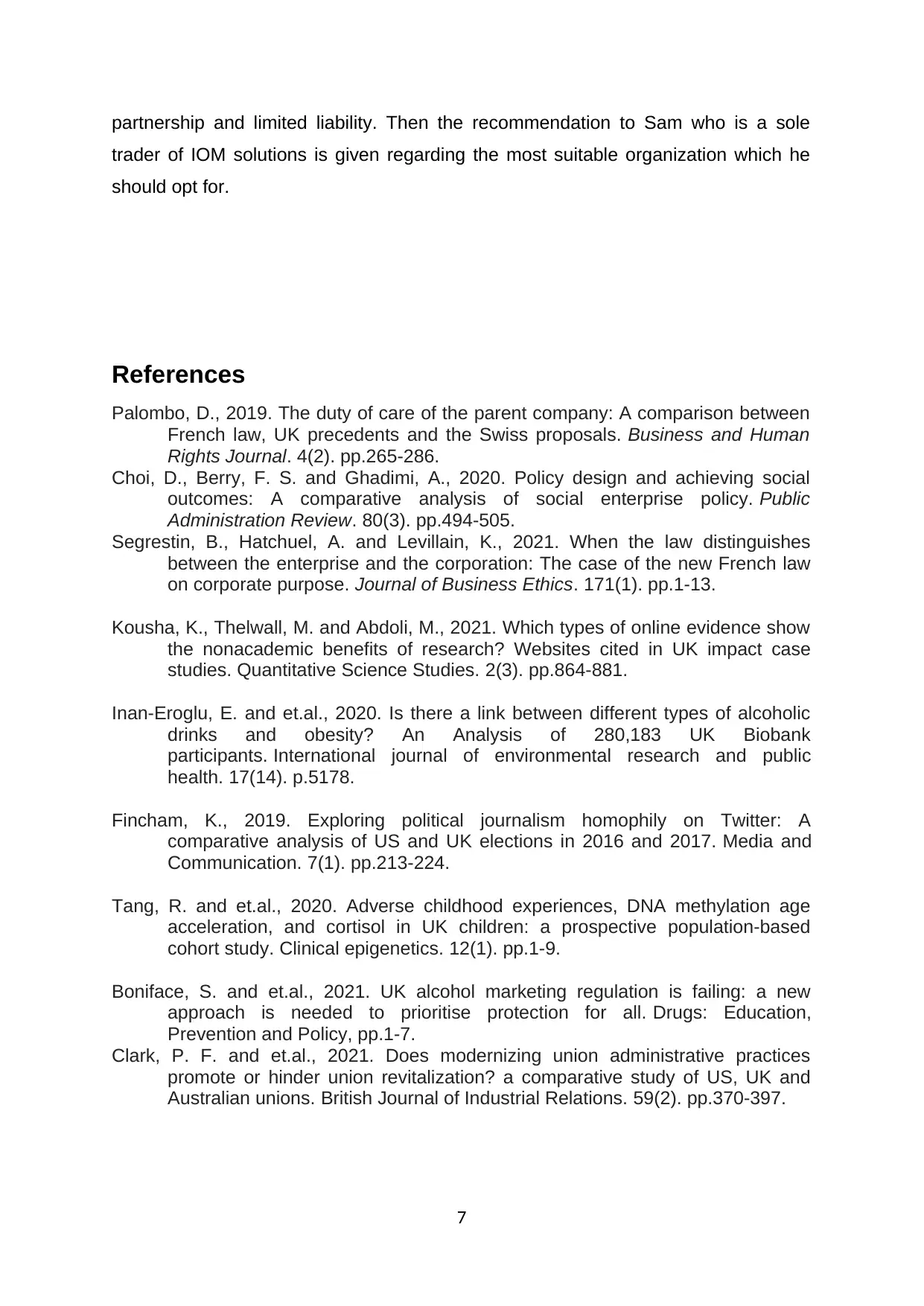
partnership and limited liability. Then the recommendation to Sam who is a sole
trader of IOM solutions is given regarding the most suitable organization which he
should opt for.
References
Palombo, D., 2019. The duty of care of the parent company: A comparison between
French law, UK precedents and the Swiss proposals. Business and Human
Rights Journal. 4(2). pp.265-286.
Choi, D., Berry, F. S. and Ghadimi, A., 2020. Policy design and achieving social
outcomes: A comparative analysis of social enterprise policy. Public
Administration Review. 80(3). pp.494-505.
Segrestin, B., Hatchuel, A. and Levillain, K., 2021. When the law distinguishes
between the enterprise and the corporation: The case of the new French law
on corporate purpose. Journal of Business Ethics. 171(1). pp.1-13.
Kousha, K., Thelwall, M. and Abdoli, M., 2021. Which types of online evidence show
the nonacademic benefits of research? Websites cited in UK impact case
studies. Quantitative Science Studies. 2(3). pp.864-881.
Inan-Eroglu, E. and et.al., 2020. Is there a link between different types of alcoholic
drinks and obesity? An Analysis of 280,183 UK Biobank
participants. International journal of environmental research and public
health. 17(14). p.5178.
Fincham, K., 2019. Exploring political journalism homophily on Twitter: A
comparative analysis of US and UK elections in 2016 and 2017. Media and
Communication. 7(1). pp.213-224.
Tang, R. and et.al., 2020. Adverse childhood experiences, DNA methylation age
acceleration, and cortisol in UK children: a prospective population-based
cohort study. Clinical epigenetics. 12(1). pp.1-9.
Boniface, S. and et.al., 2021. UK alcohol marketing regulation is failing: a new
approach is needed to prioritise protection for all. Drugs: Education,
Prevention and Policy, pp.1-7.
Clark, P. F. and et.al., 2021. Does modernizing union administrative practices
promote or hinder union revitalization? a comparative study of US, UK and
Australian unions. British Journal of Industrial Relations. 59(2). pp.370-397.
7
trader of IOM solutions is given regarding the most suitable organization which he
should opt for.
References
Palombo, D., 2019. The duty of care of the parent company: A comparison between
French law, UK precedents and the Swiss proposals. Business and Human
Rights Journal. 4(2). pp.265-286.
Choi, D., Berry, F. S. and Ghadimi, A., 2020. Policy design and achieving social
outcomes: A comparative analysis of social enterprise policy. Public
Administration Review. 80(3). pp.494-505.
Segrestin, B., Hatchuel, A. and Levillain, K., 2021. When the law distinguishes
between the enterprise and the corporation: The case of the new French law
on corporate purpose. Journal of Business Ethics. 171(1). pp.1-13.
Kousha, K., Thelwall, M. and Abdoli, M., 2021. Which types of online evidence show
the nonacademic benefits of research? Websites cited in UK impact case
studies. Quantitative Science Studies. 2(3). pp.864-881.
Inan-Eroglu, E. and et.al., 2020. Is there a link between different types of alcoholic
drinks and obesity? An Analysis of 280,183 UK Biobank
participants. International journal of environmental research and public
health. 17(14). p.5178.
Fincham, K., 2019. Exploring political journalism homophily on Twitter: A
comparative analysis of US and UK elections in 2016 and 2017. Media and
Communication. 7(1). pp.213-224.
Tang, R. and et.al., 2020. Adverse childhood experiences, DNA methylation age
acceleration, and cortisol in UK children: a prospective population-based
cohort study. Clinical epigenetics. 12(1). pp.1-9.
Boniface, S. and et.al., 2021. UK alcohol marketing regulation is failing: a new
approach is needed to prioritise protection for all. Drugs: Education,
Prevention and Policy, pp.1-7.
Clark, P. F. and et.al., 2021. Does modernizing union administrative practices
promote or hinder union revitalization? a comparative study of US, UK and
Australian unions. British Journal of Industrial Relations. 59(2). pp.370-397.
7
1 out of 8
Related Documents
Your All-in-One AI-Powered Toolkit for Academic Success.
+13062052269
info@desklib.com
Available 24*7 on WhatsApp / Email
![[object Object]](/_next/static/media/star-bottom.7253800d.svg)
Unlock your academic potential
© 2024 | Zucol Services PVT LTD | All rights reserved.



